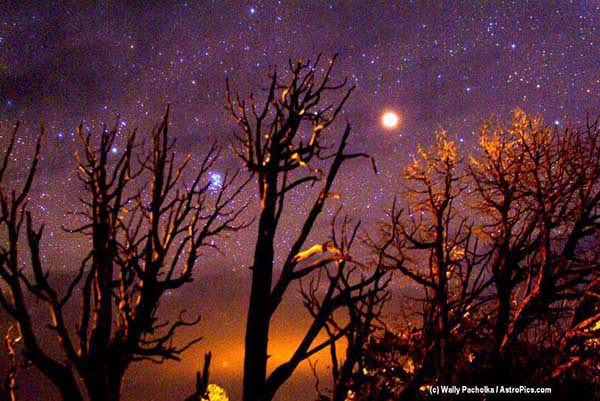The Great Nebula in Orion, also known as M42, is one of the
most famous nebulae in the sky.
The gorgeous skyscape spans nearly two degrees or about 45 light-years
at the Orion Nebula's estimated distance of 1,500 light-years
Astronomy Picture of the Day NASA
Great Orion Nebulae

Halloween and the Ghost Head Nebula NASA - October 31, 2007

SH2 136: A Spooky Nebula NASA - October 31, 2006

Martian Halloween NASA - October 31, 2005

Pumpkin Moon NASA - October 30, 2004
~~~~~~~~~~~~~~~~~~~~~~~~~~~~~~~~~~
Oct.
22, 2008: Gamma-ray bursts are by far the brightest
and most powerful explosions in the Universe, second only
to the Big Bang itself. So it might seem a bit surprising
that a group of them has gone missing.
A
single gamma-ray burst (GRB) can easily outshine an entire
galaxy containing hundreds of billions of stars. Powerful
telescopes can see them from clear across the Universe. And
because the deeper you look into space, the farther back in
time you see, astronomers should be able to see GRBs from
the time when the very first stars were forming after the
Big Bang.
Yet
they don't. Gamma-ray bursts from that early epoch seem to
be missing, and astronomers are wondering where they are.
Above: An artist's concept of the first stars forming after the Big
Bang. Credit: NASA. [Larger
image]
"This
is one of the biggest questions in the gamma-ray business,"
says astrophysicist Neil Gehrels of the Goddard Space Flight
Center. "It's something we're going to be talking a lot
about today at the GRB Symposium."
https://science.nasa.gov/headlines/y2008/22oct_missinggrbs.htm
Continues
~~~~~~~~~~~~~~~~~~~~~~~~~~~~~~~~~~~~~~~~~
LOVE THIS.."Where In The universe Quize
https://www.universetoday.com/category/where-in-the-universe/
WOW PHOTOS and it's a quize also.
~~~~~~~~~~~~~~~~~~~~~~~~~~~
Oops, TW Hydrae b Isn't a Planet; Just a Sunspot
You gotta love this about science; someone is always checking your
work. Early this year a new exoplanet discovery was announced: TW
Hydrae b, a huge planet about ten times as massive as Jupiter.
Astronomers thought the planet was in a super-tight orbit around its
host star (TW Hydrae), circling in only 3.56 days at a distance of
about 6 million kilometers, which is about 4 percent of the distance
from the Sun to the Earth.
However, another group of astronomers decided to analyze some new
optical and infrared data to confirm the radial velocity signal of the
planet. Something didn't seem right, so they ran a few more tests and
computer models and determined what they were seeing wasn't a planet.
It was a big sunspot.
"Our model shows that a cold spot covering 7% of the stellar surface
and located at a latitude of 54 deg can reproduce the reported RV
variations," the astronomers reported in their paper. The rest of the
astronomical world must agree with the new determination, as TW Hydrae
b has now been dropped from the Planet Quest New Worlds Atlas (a
fun site to peruse.) But nature doesn't like a void, — and astronomers
have been working hard in the planet-search department, — so, three new
extra solar planets have been discovered and added to the atlas, for a
current planet count of 309.
https://www.universetoday.com/2008/09/10/
oops-tw-hydrae-b-isnt-a-planet-just-a-sunspot/
#more-17879
continues.................





